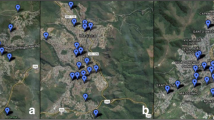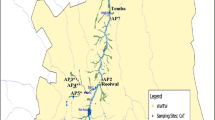Abstract
Purpose
The high incidences of waterborne diseases are frequently associated with diarrheagenic Escherichia coli (DEC). DEC may pose a health risk to people who contact surface water for recreation or domestic use. However, there is no published report on the monitoring of DEC in drinking water sources in Taiwan. In this study, the occurrence of DEC genes in raw water for water treatment plants in Taiwan was investigated.
Method
Raw water samples were taken from water treatment plants adjacent to the Kaoping River in southern Taiwan. Each water sample was treated with membrane filtration followed by DNA extraction from the concentrate and concentrate enrichment, respectively. The target genes for various DEC strains of genes were identified, including enteroaggregative E. coli (EAEC), enterohemorrhagic E. coli (EHEC), enteroinvasive E. coli (EIEC), enteropathogenic E. coli (EPEC), and enterotoxigenic E. coli (ETEC).
Results
Among 55 water samples analyzed, DEC genes were detected in 16 (29.1%) samples. Strain-specific genes for EAEC, EHEC, EIEC, and EPEC were found in the percentages of 3.6%, 10.9%, 9.1%, and 9.1%, respectively. The specific gene for ETEC is not detected in the study. By looking at the presence/absence of specific genes and water sample characteristics, water temperature was found to differ significantly between samples with and without EHEC gene. In addition, pH levels differed significantly for EHEC and EPEC presence/absence genes, and turbidity was significantly different for water with and without EPEC genes.
Conclusion
DEC genes were detected in 29.1% of the raw water samples in the study location. The potential health threat may be increased if the treatment efficiencies are not properly maintained. Routine monitoring of DEC in drinking water sources should be considered.

Similar content being viewed by others
References
Ahmed W, Sawant S, Huygens F, Goonetilleke A, Gardner T (2009) Prevalence and occurrence of zoonotic bacterial pathogens in surface waters determined by quantitative PCR. Wat Res 243:4918–4928
APHA (2005) Standard method for the examination of water and wastewater, 21st edn. APHA, WEF and AWWA, Washington
Aranda KR, Fabbricotti SH, Fagundes-Neto U, Scaletsky IC (2007) Single multiplex assay to identify simultaneously enteropathogenic, enteroaggregative, enterotoxigenic, enteroinvasive and shiga toxin-producing Escherichia coli strains in Brazilian children. FEMS Microbiol Lett 267:145–150
Bustin SA, Benes V, Garson JA, Hellemans J, Huggett J, Kubista M, Mueller R, Nolan T, Pfaffl MW, Shipley GL, Vandesompele J, Wittwer CT (2009) The MIQE guidelines: minimum information for publication of quantitative real-time PCR experiments. Clin Chem 55:611–622
Campos LC, Franzolin MR, Trabulsi LR (2004) Diarrheagenic Escherichia coli categories among the traditional enteropathogenic E. coli O serogroups—a review. Mem Inst Oswaldo Cruz 99:545–552
Chen H, Frankel G (2005) Enteropathogenic Escherichia coli: unravelling pathogenesis. FEMS Microbiol Rev 29:83–98
Clarke SC (2001) Diarrhoeagenic Escherichia coli—an emerging problem? Diagn Microbiol Infect Dis 41:93–98
Feldman KA, Mohle-Boetani JC, Ward J, Furst K, Abbott SL, Ferrero DV, Olsen A, Werner SB (2002) A cluster of Escherichia coli O157: non-motile infections associated with recreational exposure to lake water. Public Health Rep 117:380–385
Gaastra W, Svennerholm AM (1996) Colonization factors of human enterotoxigenic Escherichia coli (ETEC). Trends Microbiol 4:444–452
Gilpin BJ, Gregor JE, Savill MG (2002) Identification of the source of faecal pollution in contaminated rivers. Wat Sci Technol 46:9–15
Hamner S, Broadaway SC, Mishra VB, Tripathi A, Mishra RK, Pulcini E, Pyle BH, Ford TE (2007) Isolation of potentially pathogenic Escherichia coli O157:H7 from the Ganges river. Appl Environ Microbiol 73:2369–2372
Hsu BM, Wu SF, Huang SW, Tseng YJ, Ji DD, Chen JS, Shih FC (2010) Differentiation and identification of Shigella spp. and enteroinvasive Escherichia coli in environmental waters by a molecular method and biochemical test. Wat Res 44:949–955
Karch H, Meyer T, Rüssmann H, Heesemann J (1992) Frequent loss of shiga-like toxin genes in clinical isolates of Escherichia coli upon subcultivation. Infect Immun 60:3464–3467
Kimata K, Shima T, Shimizu M, Tanaka D, Isobe J, Gyobu Y, Watahiki M, Nagai Y (2005) Rapid categorization of pathogenic Escherichia coli by multiplex PCR. Microbiol Immunol 49:485–92
Lee CL, Chiou SI, Liu TP, Pan TM (1997) Pathogenic strains of Escherichia coli in Taiwan. Chinese J Microbiol Immunol 30:55–59
Lemarchand K, Lebaron P (2003) Occurrence of Salmonella spp. and Cryptosporidium spp. in a French coastal watershed: relationship with fecal indicators. FEMS Microbiol Lett 218:203–209
Luscher D, Altwegg M (1994) Detection of Shigellae, enteroinvasive and enterotoxigenic Escherichia coli using the polymerase chain reaction (PCR) in patients returning from tropical countries. Mol Cell Probes 8:285–290
Nataro JP, Kaper JB (1998) Diarrheagenic Escherichia coli. Clin Microbiol Rev 11:142–201
Nguyen TV, Le VP, Le HC, Weintraub A (2005) Detection and characterization of diarrheagenic Escherichia coli from young children in Hanoi, Vietnam. J Clin Microbiol 43:755–760
Olsen SJ, Miller G, Breuer T, Kennedy M, Higgins C, Walford J, McKee G, Fox K, Bibb W, Mead PA (2002) Waterborne outbreak of Escherichia coli O157 infections and hemolytic uremic syndrome: implications for rural water systems. Emerg Infect Dis 8:370–375
Preez MD, Venter SN, Theron J (2003) Detection of viable toxigenic Vibrio cholerae and virulent Shigella spp. in environmental waters by pit-stop seminested polymerase chain reaction assays. Water SA 29:177–182
Ram S, Shanker R (2005) Plasmid and drug resistance of sorbitol non-fermenting cefixime-tellurite resistant Escherichia coli isolates from Gomti river. Bull Environ Contam Toxicol 75:623–628
Ram S, Vajpayee P, Shanker R (2007) Prevalence of multi antimicrobial agent resistant, shigatoxin and enterotoxin producing Escherichia coli in surface waters of river Ganga. Environ Sci Technol 41:7383–7388
Schmidt H, Knop C, Franke S, Aleksic S, Heesemann J, Karch H (1995) Development of PCR for screening of enteroaggregative Escherichia coli. J Clin Microbiol 33:701–705
Tamanai-Shacoori Z, Jolivet-Gougeon A (1994) Detection of enterotoxigenic Escherichia coli in water by polymerase chain reaction amplification and hybridization. Can J Microbiol 40:243–249
Teng LJ, Hsueh PR, Liaw SJ, Ho SW, Tsai JC (2004) Genetic detection of diarrheagenic Escherichia coli isolated from children with sporadic diarrhea. J Microbiol Immunol Infect 37:327–34
Turner SM, Scott-Tucker A, Cooper LM, Henderson IR (2006) Weapons of mass destruction: virulence factors of the global killer enterotoxigenic Escherichia coli. FEMS Microbiol Lett 263:10–20
Vallance BA, Chan C, Robertson ML, Finlay BB (2002) Enteropathogenic and enterohemorrhagic Escherichia coli infections: emerging themes in pathogenesis and prevention. Can J Gastroenterol 16:771–778
Yang F, Yang J, Zhang X, Chen L, Jiang Y, Yan Y, Tang X, Wang J, Xiong Z, Dong J, Xue Y, Zhu Y, Xu X, Sun L, Chen S, Nie H, Peng J, Xu J, Wang Y, Yuan Z, Wen Y, Yao Z, Shen Y, Qiang B, Hou Y, Yu J, Jin Q (2005) Genome dynamics and diversity of Shigella species, the etiologic agents of bacillary dysentery. Nucleic Acids Res 33:6445–6458
Yang TC, Kao CM, Yeh TY, Lin CE, Lai YC (2006) Non-point source pollution investigation in drinking water protection area of Kaoping River Basin, Taiwan. Proceedings of the 4th WSEAS Int. Conf. on Heat Transfer, Thermal Engineering and Environment, Elounda, Greece, 34–40
Yang JR, Wu FT, Tsai JL, Mu JJ, Lin LF, Chen KL (2007) Comparison between O serotyping method and multiplex real-time PCR to identify diarrheagenic Escherichia coli in Taiwan. J Clin Microbiol 45:3620–3625
Acknowledgments
This work was supported by a research grant from the National Science Council of Taiwan, People’s Republic of China (NSC97-2221-E-194-006-MY3). We are grateful to Ryan Wallace for his editing.
Author information
Authors and Affiliations
Corresponding authors
Additional information
Responsible editor: Philippe Garrigues
Yi-Chou Chiu and Bing-Mu Hsu contributed equally to this work.
Rights and permissions
About this article
Cite this article
Huang, SW., Hsu, BM., Su, YJ. et al. Occurrence of diarrheagenic Escherichia coli genes in raw water of water treatment plants. Environ Sci Pollut Res 19, 2776–2783 (2012). https://doi.org/10.1007/s11356-012-0777-4
Received:
Accepted:
Published:
Issue Date:
DOI: https://doi.org/10.1007/s11356-012-0777-4




